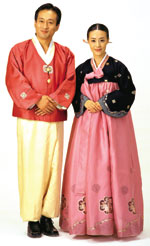
Hanbok, traditional clothing
Koreans weaved cloth with hemp and arrowroot and raised silkworms to produce silk. During the Three Kingdoms period, men wore jeogori (jacket), baji (trousers), and durumagi (overcoat) with a hat, belt and pair of shoes.
The women wore jeogori (short jacket) with two long ribbons tied to form an otgoreum (knot), a full length, high-waist wrap-around skirt called chima, a durumagi, beoseon (white cotton socks), and boat-shaped shoes.
This attire, known as Hanbok, has been handed down in the same form for men and women for hundreds of years with little change except for the length of the jeogori and chima.
Western wear entered Korea during the Korean War (1950-53), and during the rapid industrialization in the 1960s and 1970s,
Hanbok use declined, being regarded as inappropriate for casual wear. Recently, however, Hanbok lovers have been campaigning to revitalize Hanbok and have updated styles to better fit modern work environments.
A few Koreans still wear traditional Hanbok but usually only on special holidays like Seollal and Chuseok and family festivities such as Hwangap, the celebration for parents turning 60.